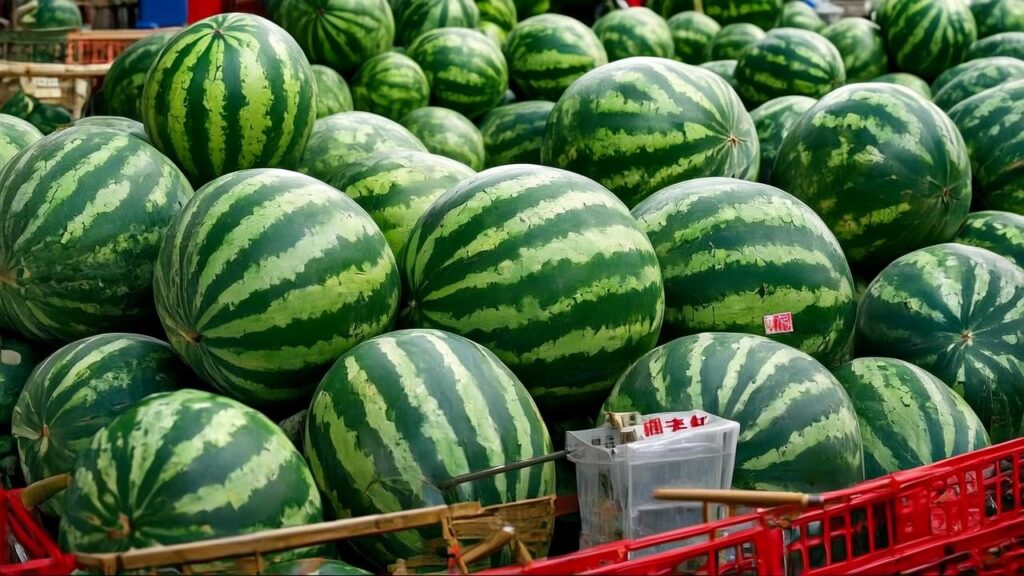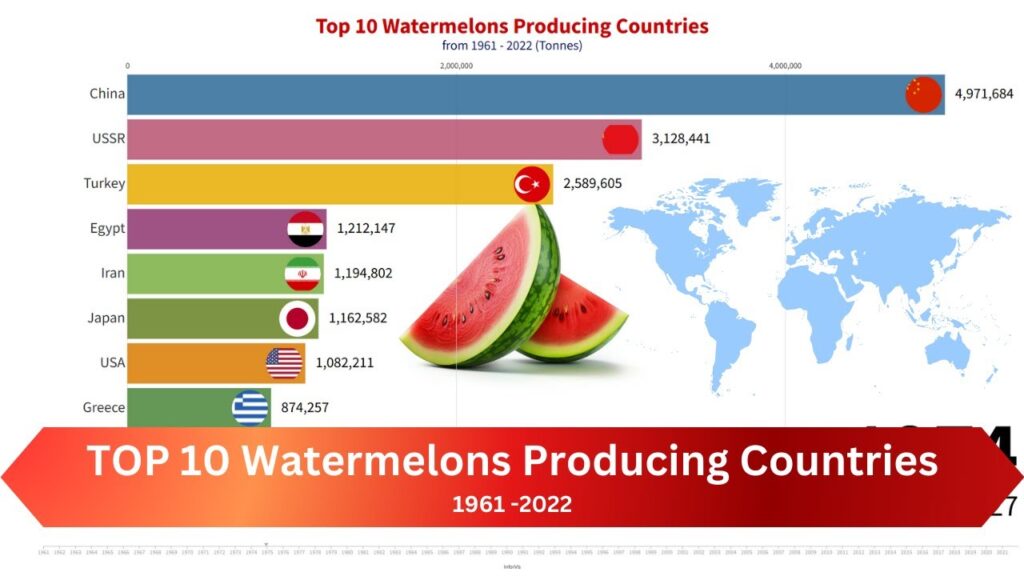For decades, one country has overwhelmingly dominated the global watermelon market, and recent data confirms its reign is stronger than ever. China is the world’s largest watermelon producer, cultivating over 60 million metric tons annually. This staggering figure accounts for more than 60% of the entire global supply, dwarfing the output of all other nations combined.

The nation’s immense production is primarily driven by a voracious domestic appetite. With a population of over 1.4 billion, China also ranks as the world’s leading consumer of the fruit. This synergy between massive-scale farming and high internal demand has created a unique and self-sustaining ecosystem for the country’s watermelon industry.
Global Watermelon Production
| Key Fact | Detail / Statistic |
| Top Producer | China |
| China’s Annual Output | ~60.4 million metric tons (2022) |
| Global Market Share | Over 60% |
| Runner-Up Producer | Turkey (~3.4 million metric tons) |
| Primary Driver | High domestic consumption |
The Roots of China’s Dominance
China’s position as the top player in the global watermelon market is not accidental. It is the result of a confluence of geographic advantages, technological advancements, deep cultural significance, and strategic agricultural policy. According to the Food and Agriculture Organization of the United Nations (FAO), the scale of China’s production is unparalleled, a status it has maintained for many years.
Vast Lands and Ideal Climates
The sheer size of China allows for diverse and extensive agricultural regions. Provinces such as Henan, Shandong, and Xinjiang offer the warm temperatures and long, sunny days essential for successful watermelon cultivation. “China’s diverse geography, with its warm summers and fertile plains, offers ideal conditions for large-scale watermelon farming,” notes a recent report from Lodhi Garden.
Xinjiang, in particular, is renowned for its unique climate of hot days and cool nights, which helps produce exceptionally sweet watermelons. This vast and varied landscape enables staggered planting and harvesting seasons, ensuring a consistent supply of the fruit to markets across the country virtually year-round.

A Thriving Domestic Market
While other nations cultivate watermelons as a key export, China’s industry is overwhelmingly supported by its own population. Reports indicate that China consumes approximately 70% of the world’s watermelons. The fruit is a cultural staple, especially during the hot summer months, where it is seen as essential for hydration and refreshment.
“It’s no exaggeration to say that about 80 percent of the watermelons and sweet melons served at people’s dining tables every day are the result of painstaking efforts made by Wu and her team,” said Zhang Wenjun, a colleague of Wu Mingzhu, an academician at the Chinese Academy of Engineering affectionately known as the “queen of melons” for her decades of work in developing new fruit varieties. This immense demand guarantees a stable market for farmers, insulating them from the volatility of international trade.
Technological and Agricultural Advancement
China has heavily invested in modernizing its agricultural sector. In watermelon farming, this includes the widespread use of greenhouse cultivation, advanced drip irrigation systems, and the development of hybrid seeds that produce higher yields and are more resistant to disease.
These techniques have significantly boosted the country’s overall agricultural output. They allow for cultivation even in off-seasons and in regions with less-than-perfect conditions, further solidifying China’s production capacity.
The Global Landscape Beyond China
While China is in a league of its own, other countries are significant contributors to the regional and global watermelon supply.
- Turkey: Consistently ranked second, Turkey produces around 3.4 million metric tons annually. Its production serves both a strong domestic market and exports to Europe and the Middle East.
- India: With its hot and arid climate zones, India produces over 3.3 million metric tons. Key growing states include Karnataka, Maharashtra, and Tamil Nadu.
- Iran & Algeria: Both are major regional producers, with Iran known for the sweetness of its fruit and Algeria leading production on the African continent.
These countries, while major players, highlight the sheer scale of China’s industry. The combined output of the next four largest producers is less than a quarter of China’s total volume.
Future of the Market
Looking ahead, China’s position as the largest watermelon producer appears secure. The government’s focus on agricultural innovation and food security, combined with the stable domestic market, provides a firm foundation for continued growth.
Trends in the global market, such as a rising consumer preference for seedless and smaller “personal-sized” melons, are being actively pursued by Chinese breeders. While a small fraction of its production is exported, any significant shift in China’s export strategy could have a substantial impact on the global market. For now, the vast majority of its harvest will continue to be enjoyed within its own borders, a testament to the fruit’s central role in the nation’s summer culture.
Mexico Solidifies Lead as World’s Top Avocado Exporter Amidst Growing Global Demand
